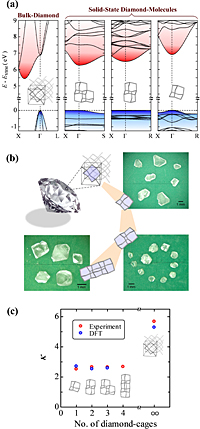‘Diamond molecules’ is the name given to a unique family of hydrocarbon molecules which consist of diamond-like structures known as diamondoids. These structures have attracted a great deal of attention lately as a novel nanotech material, since they are now isolated in sufficient quantities from crude oil.
Now, Takao Sasagawa of the Materials and Structures Laboratory at Tokyo Tech and co-workers have unveiled several noticeable properties of the diamond molecules which could prove useful for future applications.
Firstly, the researchers calculated that crystals of the diamond molecules have a direct band-gap electronic structure, just like the light-emitting semiconductors widely used in electronic devices. Moreover, the size of the band gap can be tuned using ultraviolet light (Fig (a)). This behavior could have significant potential for optoelectronic applications1.
The researchers also managed to grow single diamond molecule crystals up to one cubic centimeter in size, using a home-made transparent furnace2. This process also proved to be an environmentally friendly means of refining the samples. The obtained high-purity single crystals will accelerate fundamental and applied research in this area (Fig. (b)).
Finally, Sasagawa and co-workers used first principles calculations, followed by laboratory experiments, to show that the crystalline diamond molecules have dielectric constants less than half of that of bulk diamond3. Their results indicate that the diamond molecules are excellent candidates for low-permittivity materials to be used in the next generation of microelectronic devices (Fig. (c)).
Reference
- [1]
- “A route to tunable direct band-gap diamond devices: Electronic structures of nanodiamond crystals” T. Sasagawa* and Z.-X. Shen, J. Appl. Phys. 104, 073704 (2008). [DOI: 10.1063/1.2986637]
- [2]
- “Environmentally friendly refining of diamond-molecules via the growth of large single crystals” A. Iwasa, T. Sasagawa* et al., Crystal Growth and Design 10, 870 (2010). [DOI: 10.1021/cg901218t]
- [3]
- “Diamondoids as low-k dielectric materials” W. A. Clay, T. Sasagawa* et al., Appl. Phys. Lett. 93, 172901 (2008). [DOI: 10.1063/1.3010379]
* Materials and Structures Laboratory & Dept. of Innovative and Engineered Materials
(http://www.msl.titech.ac.jp/~sasagawa/index_e.html )
)

. Any information published on this site will be valid in relation to Science Tokyo.



